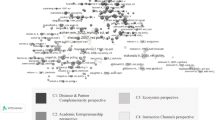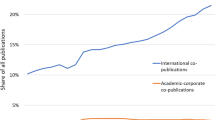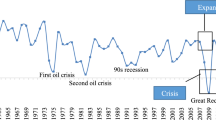Abstract
This paper investigates the scope and patterns of university–industry collaborations (UICs) in Chinese research-oriented universities. Based on the co-authored publications in international journals by Chinese universities’ academics and researchers from industries with the method of bibliometric and latent cluster analysis, this study provides detailed results on the characters and clustering features from two aspects, namely diversified resources and academic influence. The results show that, although the co-authored publications with industrial researchers only account for a small part of all publications of Chinese universities, the importance of cooperation with industries in the academic research and the scientific contribution have been strengthened in China. Meanwhile, the academic influence of co-authored publications is periodically improving, but still in the development stage of quantity rather than quality. The analyses demonstrate that there are significant differences in the matching relationship of diversified resources and academic influence between universities. Only few UICs are in both the high level of diversified resources and strong academic influence. Most of UICs should attempt to maintain diversified resources advantages whilst also try to enhance academic influence of cooperation outcomes.







Similar content being viewed by others
References
Abramo, G., D’Angelo, C. A., Di Costa, F., & Solazzi, M. (2009). University–industry collaboration in Italy: A bibliometric examination. Technovation, 29(6), 498–507.
Adams, J. D., Black, G. C., Clemmons, J. R., et al. (2005). Scientific teams and institutional collaborations: Evidence from US universities, 1981–1999. Research Policy, 34(3), 259–285.
Akaike, H. (1974). A new look at the statistical model identification. IEEE Transactions on Automatic Control, AC-19, 716–723.
Arguelles, W., et al. (2015). Characterization of metabolic syndrome among diverse Hispanics/Latinos living in the United States: Latent class analysis from the Hispanic Community Health Study/Study of Latinos (HCHS/SOL). International Journal of Cardiology, 184, 373–379.
Auranen, O., & Nieminen, M. (2010). University research funding and publication performance—An international comparison. Research Policy, 39(6), 822–834.
Azagra-Caro, J. M., Archontakis, F., Gutiérrez-Gracia, A., et al. (2006). Faculty support for the objectives of university–industry relations versus degree of R&D cooperation: The importance of regional absorptive capacity. Research Policy, 35(1), 37–55.
Biernacki, C., Celeux, G., & Govaert, G. (2003). Choosing starting values for the EM algorithm for getting the highest likelihood in multivariate Gaussian mixture models. Computational Statistics & Data Analysis, 41, 561–575.
BIS (Department of Business, Innovation and Skills). (2011). Innovation and research strategy and growth. London: The Stationery Office.
Bulteel, K., Wilderjans, T. F., Tuerlinckx, F., Ceulemans, E. (2013). CHull as an alternative to AIC and BIC in the context of mixtures of factor analyzers. Behavior Research Methods, 45(3), 782–791.
Chen, D., & Li-Hua, R. (2011). Modes of technological leapfrogging: Five case studies from China. Journal of Engineering and Technology Management, 28(1), 93–108.
D’Este, P., Tang, P., Mahdi, S., Neely, A., & Sánchez-Barrioluengo, M. (2013). The pursuit of academic excellence and business engagement: Is it irreconcilable? Scientometrics, 95(2), 481–502.
Dias, J. G. (2006). Latent class analysis and model selection. In M. Spiliopoulou, R. Kruse, C. Borgelt, A. Nürnberger, & W. Gaul (Eds.), From data and information analysis to knowledge engineering (pp. 95–102). Berlin: Springer.
Dietz, J. S., & Bozeman, B. (2005). Academic careers, patents, and productivity: Industry experience as scientific and technical human capital. Research Policy, 34(3), 349–367.
Draper, D. (1995). Assessment and propagation of model uncertainty. Journal of the Royal Statistical Society Series B, 57, 45–98.
Fonseca, J. R. S. (2009). Custer satisfaction study via a latent segment model. Consumer Services, 16, 352–359.
Fonseca, J. R. S. (2013). Clustering in the field of social sciences: That’s your choice. International Journal of Social Research Methodology, 16(5), 403–428. doi:10.1080/13645579.2012.716973.
Fonseca, J. R. S., & Cardoso, M. G. M. S. (2007). Mixture-model cluster analysis using information theoretical criteria. Intelligent Data Analysis, 11(2), 155–173.
Fu, X., & Xiong, H. (2011). Open innovation in China: Policies and practices. Journal of Science and Technology Policy in China, 2(3), 196–218.
Gazni, A., & Didegah, F. (2011). Investigating different types of research collaboration and citation impact: A case study of Harvard University’s publications. Scientometrics, 87(2), 251–265.
Gerber, M., Wittekind, A., Grote, G., & Staffelbach, B. (2009). Exploring types of career orientation: A latent class analysis approach. Journal of Vocational Behavior, 75, 303–318.
Glänzel, W., & Schubert, A. (1992). Some facts and figures on highly cited publications in the sciences, 1981–1985. Scientometrics, 25(3), 373–380.
Gulbrandsen, M., & Smeby, J. C. (2005). Industry funding and university professors’ research performance. Research Policy, 34, 932–950.
Han, Z., & Liu, Y. Q. (2010). Web 2.0 applications in top Chinese university libraries. Library Hi Tech, 28(1), 41–62.
Hayati, Z., & Didegah, F. (2010). International scientific collaboration among Iranian researchers during 1998–2007. Library Hi Tech, 28(3), 433–446.
HEFCE. (2006). Stratiogic plan 2006–11. Bristol: Higher Education Funding Council for England.
Henson, J. M., Reise, S. P., & Kim, K. H. (2007). Detecting mixtures from structural model differences using latent variable mixture modeling: A comparison of relative model fit statistics. Structural Equation Modeling, 14(2), 202–226.
Hollenstein, H. (2003). Innovation modes in the Swiss service sector: A cluster analysis based on firm-level data. Research Policy, 32(5), 845–863.
Homma, H., Ikeda, N., Attalage, R. A. (2008). Strengthening university-industry linkage in developing countries through international cooperation: Case of Sri Lanka through cooperation of Toyohashi university of technology, Japan. In M. Iskander (Ed.), Innovative techniques in instruction technology, E-learning, E-assessment, and Education (pp. 432–436). Netherlands: Springer.
Jonkers, K., & Tijssen, R. (2008). Chinese researchers returning home: Impacts of international mobility on research collaboration and scientific productivity. Scientometrics, 77(2), 309–333.
Katz, J. S., & Martin, B. R. (1997). What is research collaboration. Reseach Policy, 1(18), 1–18.
Kearnes, M. & Wienroth, M. (2009). ‘Arm’s length’? Narratives of impact and autonomy in UK research councils (Working paper). ESRC Project on Strategic Science: Research Intermediaries and the Governance of Innovation. Durham: Department of Geography, Durham University.
Kroll, H., & Liefner, I. (2008). Spin-off enterprises as a means of technology commercialization in a transforming economy—Evidence from three universities in China. Technovation, 28(5), 298–313.
Kwon, K. S., Park, H. W., So, M., & Leydesdorff, L. (2012). Has globalization strengthened South Korea’s national research system? National and international dynamics of the triple helix of scientific co-authorship relationships in South Korea. Scientometrics, 90(1), 163–176.
Lanza, S. T., Collins, L. M., Lemmon, D. R., & Schafer, J. L. (2007). PROC LCA: A SAS procedure for latent class analysis. Structural Equation Modeling, 14(4), 671–694.
Laudel, G. (2002). What do we measure by co-authorships? Research Evaluation, 11(1), 3–15.
Laursen, K., & Salter, A. (2006). Open for innovation: The role of openness in explaining innovation performance among UK manufacturing firms. Strategic Management Journal, 27(2), 131–150.
Leydesdorff, L., & Sun, Y. (2009). National and international dimensions of the triple helix in Japan: University–industry–government versus international coauthorship relations. Journal of the American Society for Information Science and Technology, 60(4), 778–788.
Liang, L., Chen, L., Wu, Y., & Yuan, J. (2012). The role of Chinese universities in enterprise–university research collaboration. Scientometrics, 90(1), 253–269.
Liu, F. C., Mang, R. K., & Jiang, N. (2011). Research on evolutionary paths of industry–university institute networks of patent collaboration based on the 985 universities. China Soft Science, 7, 178–192.
Lundberg, J., Tomson, G., Lundkvist, I., Skår, J., & Brommels, M. (2006). Collaboration uncovered: Exploring the adequacy of measuring university–industry collaboration through co-authorship and funding. Scientometrics, 69(3), 575–589.
Magidson, J., & Vermunt, J. (2004). Latent class models. In D. Kaplan (Ed.), The Sage handbook of quantitative methodology for the social sciences (pp. 175–198). Thousand Oaks: Sage.
Matos, A. L., et al. (2014). Neglect clusters of abusive parenting: A latent class analysis off families referred to child protective services in Portugal. Child Abusement and Neglection, 38, 2053–2061.
Melin, G., & Persson, O. (1996). Studying research collaboration using co-authorships. Scientometrics, 36(3), 363–377.
Mohrman, K. (2003). Higher education reform in mainland Chinese universities: An American’s perspective. Hong Kong: Hong Kong America Center, Chinese University of Hong Kong.
Morgan, G. B., Hodge, K. J., Baggett, A. R. (2015). Latent profile analysis with nonnormal mixtures: A Monte Carlo examination of model selection using fit indices. Computational Statistics and Data Analysis (in press).
Motohashi, K., & Muramatsu, S. (2012). Examining the university industry collaboration policy in Japan: Patent analysis. Technology in Society, 34(2), 149–162.
Nelson, R. R. (2004). The market economy, and the scientific commons. Research Policy, 33(3), 455–471.
Neves, B. B., & Fonseca, J. R. S. (2015). Latent class models in action: Bridging social capital & internet usage. Social Science Research, 50, 15–30.
OECD. (2003). Turning science into business, patenting and licensing at public research organizations. Paris: OECD.
Perkmann, M., King, Z., & Pavelin, S. (2011). Engaging excellence? Effects of faculty quality on university engagement with industry. Research Policy, 40(4), 539–552.
Peters, L. S., & Fusfeld, H. (1982). University–industry research relationships. National Science Foundation, 235, 236–237.
Ru, P., Zhi, Q., Zhang, F., Zhong, X., Li, J., & Su, J. (2012). Behind the development of technology: The transition of innovation modes in China’s wind turbine manufacturing industry. Energy Policy, 43, 58–69.
Savitskaya, I., Salmi, P., & Torkkeli, M. (2010). Barriers to open innovation: Case China. Journal of Technology Management & Innovation, 5(4), 10–21.
Schwarz, G. (1978). Estimating the dimension of a model. The Annals of Statistics, 6, 461–464. doi:10.1214/aos/1176344136.
Sclove, S. L. (1987). Application of model-selection criteria to some problems in multivariate analysis. Psychometrika, 52(3), 333–343.
Sooryamoorthy, R. (2009). Do types of collaboration change citation? Collaboration and citation patterns of South African science publications. Scientometrics, 81(1), 177–193.
Tijssen, R. J. W. (2004). Is the commercialisation of scientific research affecting the production of public knowledge?: Global trends in the output of corporate research articles. Research Policy, 33(5), 709–733.
Tijssen, R. J., Van Leeuwen, T. N., & Van Wijk, E. (2009). Benchmarking university–industry research cooperation worldwide: Performance measurements and indicators based on co-authorship data for the world’s largest universities. Research Evaluation, 18(1), 13–24.
Trigo, A., & Vence, X. (2012). Scope and patterns of innovation cooperation in Spanish service enterprises. Research Policy, 41(3), 602–613.
Vrieze, S. I. (2012). Model selection and psychological theory: A discussion of the differences between the Akaike information criterion (AIC) and the Bayesian information criterion (BIC). Psychological Methods, 17, 228–243. doi:10.1037/a0027127.
Wang, J., & Shapira, P. (2011). Funding acknowledgement analysis: An enhanced tool to investigate research sponsorship impacts: The case of nanotechnology. Scientometrics, 87(3), 563–586.
Wong, P. K., & Singh, A. (2013). Do co-publications with industry lead to higher levels of university technology commercialization activity? Scientometrics, 97(2), 245–265.
Zheng, J., Zhao, Z. Y., Zhang, X., Chen, D. Z., Huang, M. H., Lei, X. P., et al. (2012). International scientific and technological collaboration of China from 2004 to 2008: A perspective from paper and patent analysis. Scientometrics, 91(1), 65–80.
Zhou, P., & Glänzel, W. (2010). In-depth analysis on China’s international cooperation in science. Scientometrics, 82(3), 597–612.
Zhou, P., Thijs, B., & Glänzel, W. (2009). Regional analysis on Chinese scientific output. Scientometrics, 81(3), 839–857.
Acknowledgments
The work was supported by the National Natural Science Foundation of China (Grant Nos. 71473086, 71233003); Key Projects of Philosophy and Social Sciences Research, Ministry of education (Grant No. 12JZD042) and the National Natural Science Foundation of Guangdong Province in China (Grant No. S2013010011823). And we would like to thank Yi Li since she made a contribution to completing the preliminary work. We also appreciate that the great advices are provided by the reviewers.
Author information
Authors and Affiliations
Corresponding author
Rights and permissions
About this article
Cite this article
Fan, X., Yang, X. & Chen, L. Diversified resources and academic influence: patterns of university–industry collaboration in Chinese research-oriented universities. Scientometrics 104, 489–509 (2015). https://doi.org/10.1007/s11192-015-1618-2
Received:
Published:
Issue Date:
DOI: https://doi.org/10.1007/s11192-015-1618-2




